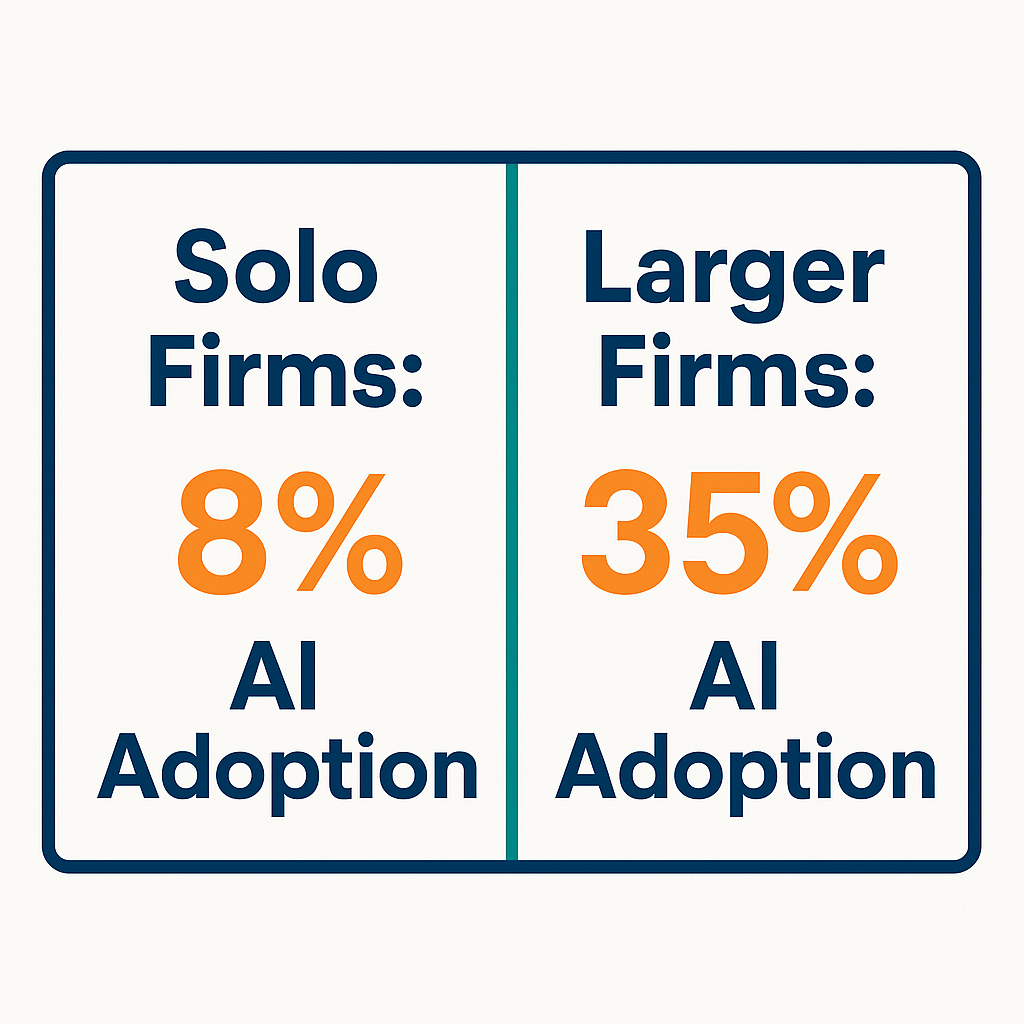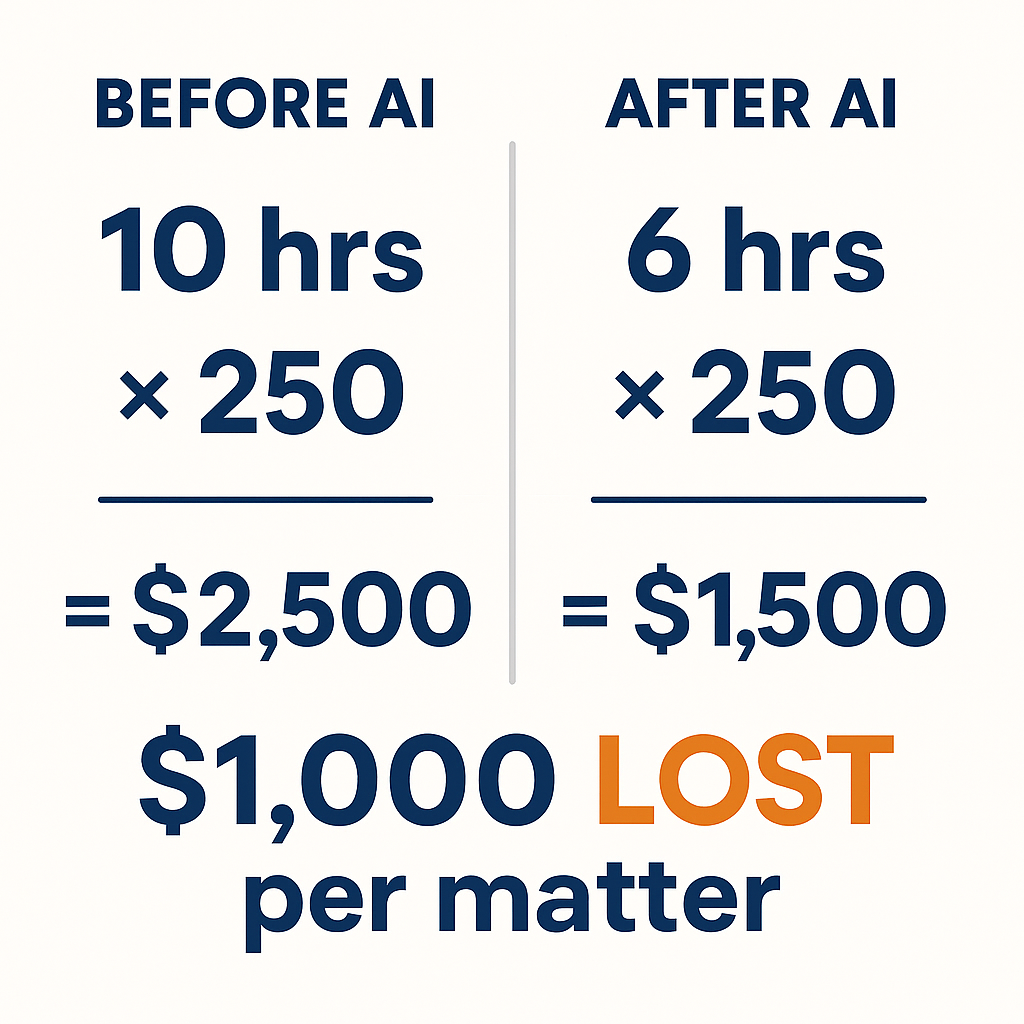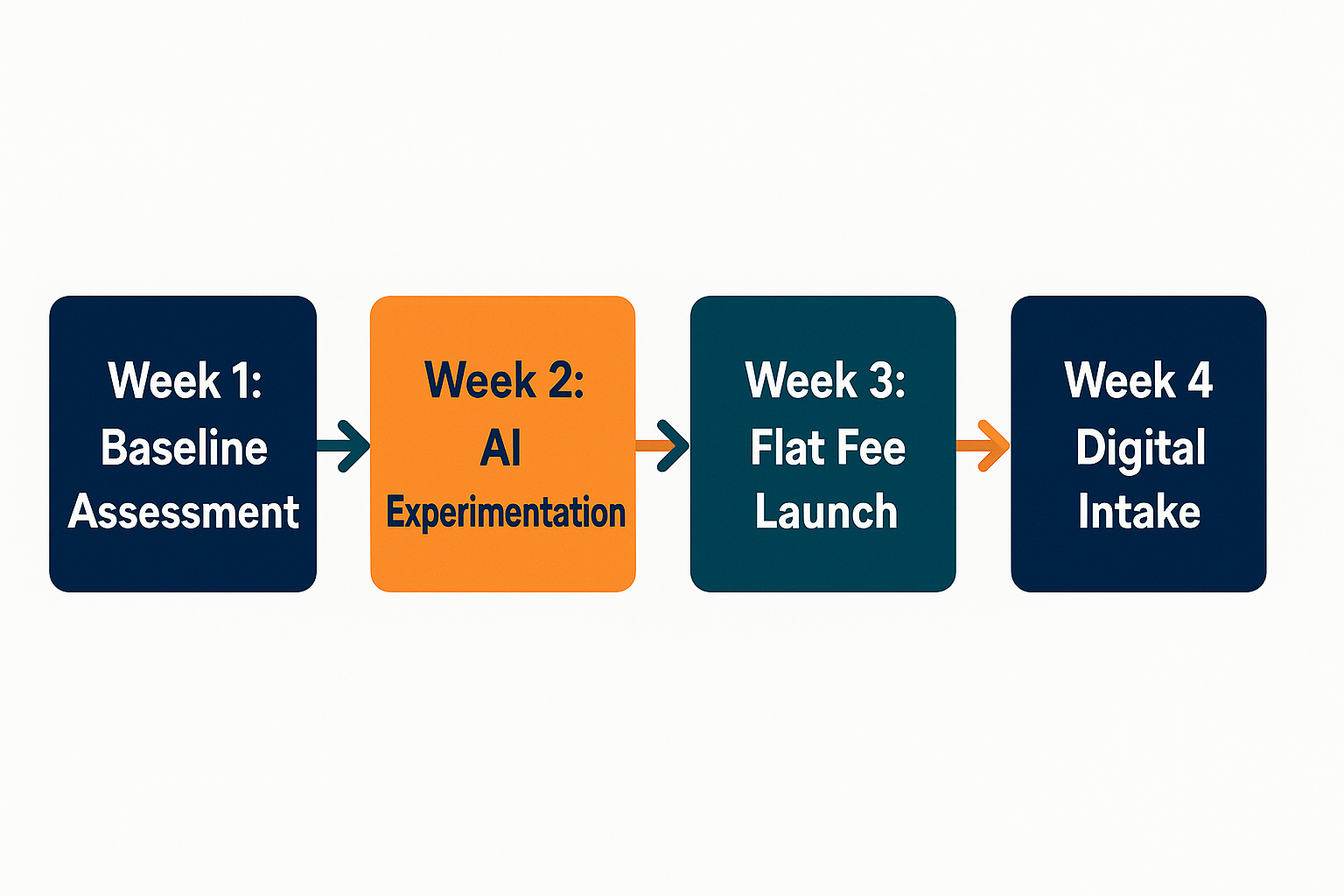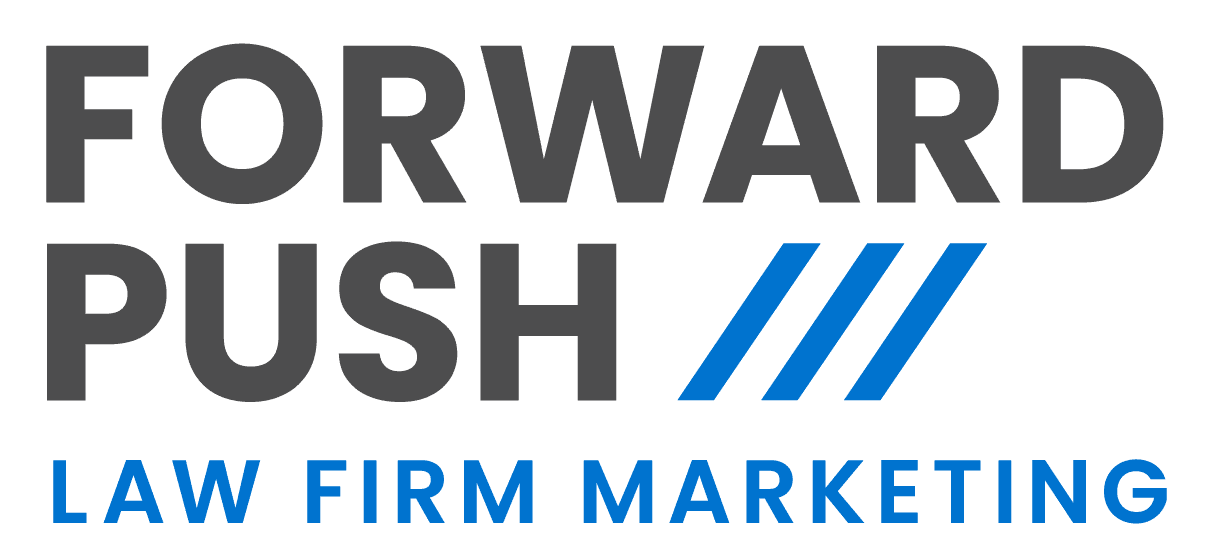By Marc Apple ● ● 14 min read

Table of Contents
TL:DR Clio's 2025 Legal Trends Report reveals an unexpected story: responsible lawyers in solo and small law firms that embrace technology-driven efficiency are achieving double the revenue growth of industry averages; without adding staff. Here's the strategic playbook the data reveals, and exactly how to implement it in your practice.
No time to read? Listen to a conversation about this blog post instead.
Solo and small law firms have historically lagged larger competitors in revenue per lawyer, but Clio’s 2025 Legal Trends Report (analyzing aggregated, anonymized data from tens of thousands of legal professionals plus surveys of 1,702 U.S. legal professionals and 1,000 consumers) reveals a dramatic reversal for growth-oriented firms.
Responsible lawyers in solo and small firms (2-4 employees) who focus on efficiency and technology adoption saw twice the revenue growth compared to industry averages between 2020-2023.
The differentiator isn’t hiring more lawyers; it’s the vertical growth model. While larger firms scale horizontally by expanding headcount, successful solo and small firms are scaling vertically: increasing the productivity and efficiency of existing staff through technology, automation, and systematic workflows.
The results are measurable: growing solo firms handle 37% more cases than other solos, while growing small firms handle 25% more cases than their peers. Meanwhile, larger firms in the growth category only see 5-6% higher case volumes. The most efficient small firms are outperforming competitors not by getting bigger, but by getting better.
Below is a strategic analysis of the critical trends driving small firm growth and the framework to implement them in your practice.
The Opportunity: Technology-Driven Vertical Growth
The Vertical Growth Model: Efficiency Over Expansion
The 2025 Legal Trends Report identifies two distinct growth models in legal practice:
Vertical Growth (Solo & Small Firms 2-4 employees):
Growth by increasing efficiency and productivity of existing staff, handling more cases and generating more revenue without raising headcount or overhead. Technology and automation are the primary enablers. This model builds resilience during slower periods because fixed costs remain stable.
Horizontal Growth (Larger Firms 5+ employees):
Growth by hiring more lawyers and expanding staff to increase total firm capacity rather than per-lawyer productivity.
Here’s why this matters strategically: Solo and small firms have a structural advantage in vertical growth. You can implement new tools, change workflows, and adopt technology in days or weeks, not the months or quarters larger firms require for consensus-building and firm-wide rollouts.
The data proves vertical growth works. Responsible lawyers in solo and small firms (2-4 employees) saw twice the revenue growth compared to industry averages between 2020-2023. Growing solo practitioners increased their revenue per lawyer while handling 37% more cases than other solos. Growing small firms (2-4 employees) handled 25% more cases than their peers. These aren’t marginal improvements; they’re transformational results from the same number of attorneys doing systematically better work.
For context on the baseline: in 2024, solo practitioners averaged $83,219 in annual billables with median earnings of $137,948, while small firms (2-4 employees) averaged $156,963 in billables per responsible lawyer with median earnings of $225,236. Larger firms (5-19 employees) averaged $249,758 in billables per responsible lawyer with median earnings of $365,309.
The strategic insight: You don’t need to hire to grow. You need to systematically eliminate inefficiency so each lawyer can handle more matters at higher quality. This is the path to sustainable, profitable growth for practices under 5 attorneys.

The Technology-Enabled Capacity Advantage
The most successful solo and small firms in Clio’s research share common technology adoption patterns. Growing firms invest more heavily in three key technology categories:
Client Intake and CRM Systems: Tools that capture leads, automate follow-up, and streamline the path from initial contact to signed engagement.
Document Automation: Systems that reduce time spent on routine documents while maintaining consistency and quality.
Online Payment Processing: Integrated payment systems that reduce collection time and improve cash flow.
The report findings are clear: growing firms use more products and use features more deeply than peers. They’re not just buying software; they’re systematically implementing tools that eliminate friction and administrative burden.
The impact is measurable in caseload data: Growing solos handle 37% more cases than other solo practitioners. Growing small firms handle 25% more cases than their peers. These capacity increases come from eliminating inefficiency in client intake, reducing administrative overhead, and automating routine tasks, not from working longer hours.
But here’s the strategic challenge the data reveals: Many attorneys who’ve adopted efficiency tools report a new bottleneck. As one solo lawyer told Clio researchers: “If I could find the clients, I could do 10 times more work.”
Technology has solved the capacity problem but exposed the client acquisition problem. Efficient firms now have the ability to handle significantly more cases, but many lack the marketing systems to generate consistent lead flow. This creates a growth paradox: you’ve built the machine to scale, but you’re running it at 30-40% capacity.
The firms achieving 2x revenue growth have solved both problems: they’ve built efficiency systems AND client acquisition systems.
AI Adoption: The New Efficiency Frontier
AI adoption is now mainstream in legal practice, with 79% of legal professionals reporting AI use across the industry. However, adoption patterns vary significantly:
Larger firms see more AI adoption than smaller firms, following historical technology adoption patterns. But what matters more than adoption rates is adoption depth.
The report identifies “wide adopters,” legal professionals who’ve integrated AI broadly across their practice. Among these wide adopters, 69% report positive revenue impact, compared to 36% overall. This isn’t correlation, it’s causation. Systematic AI implementation drives measurable financial results.
More tellingly, growing firms are twice as likely to be using AI in Clio compared to stable or shrinking firms. Technology adoption is becoming a defining characteristic of growth-oriented practices.
Looking forward, 82% of legal professionals expect to use more AI in the next 12 months, indicating accelerating adoption rather than a plateau. The competitive environment is shifting rapidly.
Yet more than half of firms report having no AI policy in place, or staff are unaware of any policy. This creates risk: firms are adopting powerful tools without governance frameworks, training protocols, or clear guidance on appropriate use.

The Billing Model Evolution: AI Makes Hourly Billing Obsolete
Here’s the structural challenge AI creates for traditional billing: the billable hour is increasingly incompatible with AI-driven efficiency.
The report cites research showing that up to 74% of billable work could be automated. When AI reduces legal research time by 30-50% and document drafting by 40-60%, hourly billing becomes an economic trap. You either:
1. Bill clients for fewer hours (reducing revenue), or
2. Bill full hours for AI-assisted work (creating transparency and trust issues)
Neither option is sustainable.
The market is responding. In 2024, 59% of firms used flat fees (exclusively or alongside hourly billing), up from 54% who billed both hourly and flat fees. The shift toward value-based pricing is accelerating.
Among AI wide adopters who adjusted their pricing in response to AI:
- 26% increased fees (capturing value created by better work product)
- 11% reduced fees (passing some efficiency gains to clients for competitive advantage)
- 8% introduced new fee types (creating innovative pricing structures aligned with AI-enabled delivery)
The strategic implication: Flat fees aren’t just client-friendly, they’re the only pricing model that captures the value of AI efficiency without penalizing firms for getting faster.
When you reduce estate planning time from 10 hours to 6 hours with AI assistance, a $2,800 flat fee delivers the same revenue with 40% better margin. Hourly billing at $250/hour drops from $2,500 to $1,500, a $1,000 loss per matter.
Lawyer Well-Being: The Hidden Cost of Inefficiency
The 2025 report reveals significant well-being challenges across the profession:
- 42% of attorneys feel burned out regularly
- 49% cite inability to disconnect from work
- 44% report trouble focusing on tasks
These aren’t just quality-of-life issues—they’re productivity and sustainability issues. Burned-out attorneys make mistakes, deliver lower-quality work, and eventually leave practice or scale back significantly.
The report notes that technology has shown to improve mental bandwidth by reducing administrative burden. This is a critical but under-discussed benefit of vertical growth strategies: efficiency tools don’t just increase revenue—they reduce the cognitive load and administrative friction that drives burnout.
Solo practitioners face particular challenges because every administrative task, client call, and operational decision falls on one person. Technology that automates routine work, streamlines client communication, and reduces context-switching directly improves attorney mental health and job satisfaction.
Why This Matters Now: The Efficiency Gap Is Widening
The report data reveals an urgent competitive dynamic: the efficiency gap between technology-adopters and traditional firms is accelerating.
Growing firms are achieving compound advantages:
Capacity → Market Share: Firms handling 37% more cases per lawyer can serve more clients without raising prices, expanding their market presence while competitors stay flat or decline.
Efficiency → Profitability: Lower time-per-matter means higher effective rates even at competitive pricing. A flat fee that takes you 6 hours instead of 10 hours generates 67% higher hourly equivalent.
Quality → Reputation: Automated systems reduce errors, provide consistent client communication, and deliver predictable timelines. Better client experience generates reviews, referrals, and repeat business that traditional firms struggle to match.
Speed → Conversion: Digital intake and automated systems mean you can move from initial contact to signed engagement in 24-48 hours while competitors are still playing phone tag.
These advantages multiply across every dimension of practice simultaneously. What looks like a modest efficiency improvement in one area becomes transformational when applied systematically across your entire operation.
The mathematical problem most small firms haven’t internalized: Compound advantages don’t scale linearly, they scale exponentially. The growing firms achieving 2x revenue growth aren’t doing one thing well, they’re systematically optimizing every aspect of their practice.
Meanwhile, the data shows vulnerability for firms that neither grow nor optimize. Solo firms in the “stable” category (maintaining consistent revenue without expansion) experienced the largest drop in revenue per lawyer among stable firms, though some maintained profitability by reducing overhead and shortening collection processes. Solos and small firms in the “shrinking” category saw the most pronounced revenue declines, underscoring their vulnerability to market shifts.
The competitive window for adopting vertical growth strategies is open, but it’s narrowing. The 82% who expect increased AI usage in the next 12 months aren’t making predictions—they’re reporting present momentum. Firms that move now capture market share while competitors hesitate. Firms that delay face an increasingly difficult competitive environment.
How to Build Your Vertical Growth System: Strategic Response Framework
Phase 1: Technology Foundation (Weeks 1-4)
The most successful firms in Clio’s research share three technology categories that drive measurable results:
Client Intake and CRM
Digital systems that capture prospect information, automate follow-up sequences, and streamline the path from inquiry to engagement. Growing firms invest more heavily in these tools than stable or shrinking firms, and the impact shows in their ability to convert prospects efficiently.
Document Automation
Template libraries and automated drafting tools for routine documents (engagement letters, standard motions, contracts, estate planning documents) that maintain consistency while reducing drafting time.
Online Payment Systems
Integrated payment processing that makes it easy for clients to pay retainers, flat fees, and ongoing bills. Automated payment plans for larger matters improve cash flow predictability.

Implementation sequence:
- Week 1: Add online scheduling capability to website and intake process
- Week 2: Create digital intake forms that pre-qualify leads and gather information
- Week 3: Set up e-signature system for engagement letters and routine agreements
- Week 4: Implement online payment processing with automated reminders
Expected outcome: Measurable reduction in administrative time, faster client onboarding, improved cash flow.
Phase 2: AI Integration (Weeks 5-8)
With 79% industry-wide adoption and 82% planning increased usage in the next 12 months, AI integration is no longer optional for growth-oriented firms.
Start with Generic AI Tools
Tools like ChatGPT, Claude, and other general-purpose AI platforms provide immediate productivity gains at low cost ($0-20/month). Use these daily for 30 days to build comfort with AI-assisted work.
Applications:
- Legal research assistance and case law analysis
- First-draft client communications and letters
- Contract and document review for issues or inconsistencies
- Meeting preparation and consultation planning
Expand to Legal-Specific AI
After establishing baseline comfort, add AI-enhanced legal research platforms and practice-specific tools. Track impact rigorously:
- Document baseline time spent on research and drafting
- Measure time savings weekly after implementation
- Calculate value created (hours saved × your effective rate) versus tool cost
- Target minimum 5x ROI to justify continued investment
Establish AI Governance
More than half of firms have no AI policy or staff are unaware of any policy. Don’t be in this category. Create simple guidelines:
- What AI tools are approved for use
- What types of work are appropriate for AI assistance
- Human review requirements (especially for client-facing documents)
- Client confidentiality and data security standards
- Quality control checkpoints
Track Revenue Impact
The report shows 69% of wide AI adopters report positive revenue impact. Track your own results:
- Time saved per week through AI assistance
- Additional matters handled due to increased capacity
- Revenue increase attributable to higher caseload
- Client satisfaction scores (are faster turnarounds noticed and valued?)
Expected outcome: 15-25% capacity increase, measurable time savings, foundation for continued AI expansion.
Phase 3: Flat Fee Implementation (Weeks 9-12)
With 59% of firms now using flat fees and AI making hourly billing increasingly problematic, transitioning to value-based pricing protects revenue while meeting client expectations.
Choose Pilot Services Strategically
Select based on:
- High volume (test with multiple clients to refine pricing)
- Predictable scope (clearly defined deliverables)
- Defined value (clients understand benefit regardless of time spent)
Good candidates: Uncontested family law matters, business formation, simple estate planning, traffic ticket defense, trademark applications.
Calculate Pricing Using Historical Data
Review time records for last 10-15 similar matters. Calculate 75th percentile time (not average, this protects against scope creep). Determine pricing: (75th percentile hours × your effective rate) × 1.15-1.25 buffer = flat fee starting point.
Structure Engagement Letters for Scope Protection
- State flat fee amount clearly upfront
- List exactly what’s included in detail
- List what’s NOT included (scope boundaries matter)
- Define scope change terms and additional fee triggers
- Set clear payment terms (common: 50% upfront, 50% at completion or milestone)
- Limit revisions explicitly (e.g., “includes two rounds of revisions”)
Consider Tiered Packages
For transactional work, offer Basic/Standard/Premium tiers:
- Basic: Core deliverable with standard terms
- Standard: Core deliverable plus common add-ons
- Premium: Comprehensive package with expedited timeline or enhanced service
This approach captures more value from clients who want additional service while maintaining accessible entry price point.
Track and Refine
Monitor first 10-15 flat fee matters closely:
- Actual time spent versus pricing
- Scope creep issues (what triggers additional work?)
- Client satisfaction (do they perceive value?)
- Profitability (effective rate versus target)
Adjust pricing and scope definitions based on real data.
Expected outcome: Proven flat fee model in one practice area, clear pricing framework, foundation for expansion to additional services.
Phase 4: Client Acquisition System (Weeks 13-16)
This is where many efficiency-focused firms stall. You’ve built capacity to handle 37% more cases, but where do the clients come from?
Referral Network Enhancement
Your existing referral sources are likely your highest-value channel. Implement systematic referral cultivation:
- Send thank-you message within 24 hours of every referral
- Provide case outcome updates to referral sources (with client permission)
- Schedule quarterly check-ins with top referrers
- Make referring easy: create simple referral landing page with online scheduling
- Follow up on every referral within 4 hours maximum
Digital Presence Optimization
Most solo and small firm websites don’t convert traffic effectively. Fix fundamental issues:
- Clear service descriptions with pricing transparency (flat fees where offered)
- Strong calls-to-action (“Schedule Free Consultation” not generic “Contact Us”)
- Fast-loading mobile experience with online scheduling integrated
- Client reviews and testimonials prominently displayed
- Location-specific content for local SEO
Content-Based Lead Generation
Growing firms attract prospects by answering common legal questions:
- Write 1-2 articles monthly addressing questions you hear repeatedly in consultations
- Create comprehensive FAQ pages for each practice area
- Record short video answers to common questions (video content ranks well)
This content serves dual purpose: helps potential clients find you via search, and pre-educates prospects so consultations are more productive.
Implement Basic Metrics Tracking
- Lead source for every new matter (referral, website, online search, etc.)
- Consultation-to-engagement conversion rate
- Average time from initial contact to signed engagement
- Cost per lead for any paid channels
Review monthly and adjust based on data.
Expected outcome: 20-40% increase in qualified lead flow to fill capacity built in earlier phases.
What to Do This Week: Your 30-Day Action Plan
Week 1: Assessment and Baseline
Current State Documentation
- Calculate current billable revenue per responsible lawyer (compare to Clio benchmarks: $83,219 for solos, $156,963 for small firms 2-4 employees)
- Count active matters per lawyer (growing solos handle 37% more than average)
- List all current technology tools and monthly costs
- Identify which tools you’re actually using deeply versus just paying for
Capacity Analysis
- How many new matters could you realistically handle with current staffing?
- What prevents you from taking on more cases right now?
- Which administrative tasks consume disproportionate time?
- Where do prospects fall out of your intake funnel?
Lead Flow Baseline
- Track lead sources for past 90 days
- Measure consultation-to-engagement conversion rate
- Calculate average time from initial contact to signed engagement
Week 2: Technology Quick Wins
Implement Online Scheduling
Choose tool that integrates with your calendar. Add scheduling link to: email signature, website, Google Business Profile, social media profiles.
Create Digital Intake Form
Build form with 6-8 key questions to pre-qualify leads. Include in confirmation email after someone books consultation. Test with next 5-10 prospects and refine.
Expected outcome: Reduce phone tag, improve consultation preparation, capture leads outside business hours.
Week 3: AI Experimentation
Setup (Monday-Tuesday)
Create account with generic AI tool (ChatGPT, Claude, or similar). Learn basic prompting and interaction patterns.
Testing (Wednesday-Friday)
- Use AI for legal research on next 2-3 matters
- Have AI draft outline for client email or letter
- Ask AI to review document for potential issues
- Track time spent versus traditional methods
Document both time savings and quality (does AI output require significant editing?).
Expected outcome: 5-10 hours saved during week, data showing whether tool justifies cost, baseline for expansion.
Week 4: Flat Fee Launch Preparation
Monday: Choose Pilot Service
Select one high-volume, predictable-scope service for flat fee testing.
Tuesday-Wednesday: Calculate Pricing
Review time records for last 10-15 similar matters. Calculate 75th percentile time. Apply formula: (Hours × effective rate) × 1.20 buffer = floor price.
Thursday: Create Engagement Letter
Draft engagement letter that clearly states flat fee amount, lists what’s included/excluded, defines scope change terms, and sets payment terms.
Friday: Update Marketing
Add pricing information to website. Update Google Business Profile. Prepare to offer flat fee option to next appropriate prospect.

The Growth Choice: Vertical vs. Stagnant
Three data-driven imperatives emerge from Clio’s 2025 Legal Trends research:
Build vertical growth systems: Successful solo and small firms achieve 2x revenue growth vs. industry averages by systematically increasing efficiency rather than headcount. They handle 25-37% more cases per lawyer through technology, automation, and process optimization.
Adopt AI strategically: With 79% industry adoption, 82% planning increased usage, and 69% of wide adopters reporting positive revenue impact, AI integration is no longer experimental—it’s essential for competitive practice.
Evolve pricing models: With 59% of firms now using flat fees and AI making hourly billing increasingly problematic, transitioning to value-based pricing protects revenue while meeting client expectations.
The competitive reality: Growing firms are pulling away from stagnant competitors through compound advantages in capacity, efficiency, quality, and speed. The data is unambiguous, solo and small firms that achieved 2x revenue growth share common characteristics: aggressive technology adoption, systematic efficiency improvement, and higher caseload per lawyer.
Meanwhile, firms that neither grow nor optimize face declining revenue per lawyer. The stable and shrinking categories in Clio’s research show that standing still means falling behind in an increasingly efficient marketplace.
Solo and small firms have structural advantages larger firms can’t match: agility (implement new tools in days), direct client relationships (every client works with decision-makers), and lower overhead (more flexible pricing and experimentation).
The firms achieving extraordinary results aren’t doing anything mystical. They’re executing systematic vertical growth strategies: eliminate inefficiency, increase per-lawyer capacity, build client acquisition systems, capture more revenue without adding fixed costs.
The 2025 Legal Trends Report isn’t predicting the future, it’s documenting what’s already working for growth-oriented solo and small firms. You have the same data now. The 30-day plan above provides concrete next steps.
The question: Will you build your vertical growth system this quarter, or watch competitors implement these strategies first?




